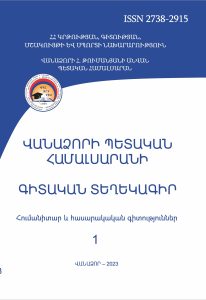The Penetration of French Terms into the English-Speaking
Scientific Proceedings of Vanadzor State University Humanitarian and Social Sciences (ISSN 2738-2915)
2023 vol 1
The Penetration of French Terms into the English-Speaking Diplomatic Discourse
Ella Sargsyan
Summary
 Key words: interrelation, penetration, diplomatic terms and phrases, borrowings, interaction, French influence, international relations, vocabulary, political discourse, negotiations, loan words
Key words: interrelation, penetration, diplomatic terms and phrases, borrowings, interaction, French influence, international relations, vocabulary, political discourse, negotiations, loan words
In the history of the English language, French has long been considered to be the ideal “donor” language. Since the Norman Conquest, French has brought new words to the English vocabulary. Many studies of the language and its evolution have focused their linguistic attention on the French effect on the lexicon of English. Vocabulary has always been the most dynamic aspect of a language. France was a major military, economic, and cultural power for hundreds of years, and as a result, French became the universal language of politics. Diplomatic correspondence between various nations was conducted in French. The French language is still well-represented in the terminology of diplomacy. At one time the famous British diplomat Harold Nicholson called French the language of “geometric precision”.
French, with its accuracy, lexical composition and syntax, have contributed, like other languages, to the improvement of diplomatic negotiations conducted in English. And what does diplomacy mean if not the art of negotiation, in which language plays a key role. English, having proven itself in the field of science, in the field of diplomacy, shows the huge impact of French especially through its vocabulary. The French language, thanks to its precision and clarity, clearly indicates the great influence on English. French influence on English has proven many times its legal precision that suits international negotiations. After so many years of dominating international relations French has had directly a great impact on the English diplomatic practice.
